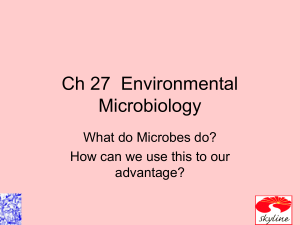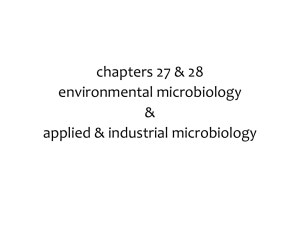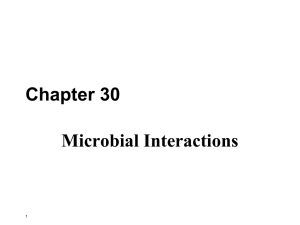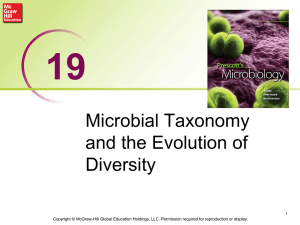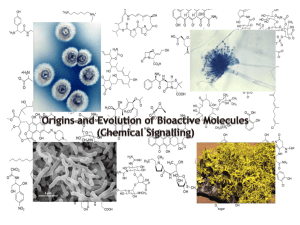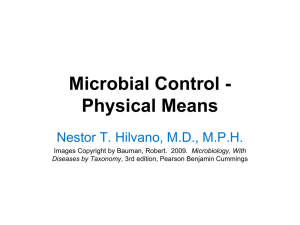Mircobiology - Chapter 1 - Microbiology and Molecular Genetics at
advertisement
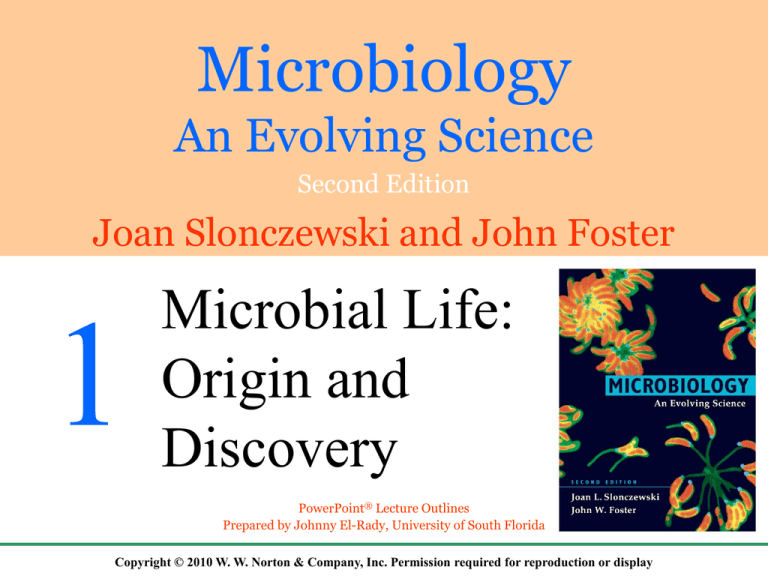
Microbiology An Evolving Science Second Edition Joan Slonczewski and John Foster 1 Microbial Life: Origin and Discovery PowerPoint® Lecture Outlines Prepared by Johnny El-Rady, University of South Florida Copyright © 2010 W. W. Norton & Company, Inc. Permission required for reproduction or display Chapter Overview What is a microbe? ● How microbes have shaped human history ● The development of medical microbiology ● The development of microbial ecology ● The microbial family tree in all its splendor ● The advent of cell biology and the brilliant DNA revolution ● 2 What Is a Microbe? A microbe is a living organism that requires a microscope to be seen. - Microbial cells range in size from millimeters (mm) to 0.2 micrometer (mm). - Viruses may be 10 times smaller. Some microbes consist of a single cell. Each microbe contains in its genome the capacity to reproduce its own kind. 3 Representative Microbes Figure 1.2 4 What Is a Microbe? The simple definition of a microbe, however, leaves us with contradictions. 1. Supersize microbial cells - e.g.: Thiomargarita namibiensis 2. Microbial communities - e.g.: Biofilms 3. Viruses - e.g.: Mimivirus The largest prokaryote, Thiomargarita namibiensis compared to a fruit fly, Drosophila. A single cell can reach a diameter of 0.75 Figure 1.1 mm. Thiomargarita namibiensis, which means 'sulfur pearl from Namibia Figure 1.4 5 Thiomargarita namibiensis is found in the sulfur-rich sediments of the ocean floor along the west coast of Africa, where they play an important ecological role. By oxidizing sulfur they act as detoxifiers, removing the poisonous gas from the water and keeping it hospitable for the fish and other marine organisms. 6 Microbes include members of the three domains of life. Figure 1.5 7 Microbial Genomes Are Sequenced A genome is the total genetic information contained in an organism’s chromosomal DNA. The first genome sequenced was that of a virus, bacteriophage fX174. Nearly two decades passed before the first genome sequence of a cellular microbe was completed – Haemophilus influenzae. 8 Figure 1.8 9 Microbes Shape Human History Microbes have shaped human culture since our earliest civilizations. - Yeasts and bacteria = Foods and beverages - “Rock-eating” bacteria = Lithotrophs enabled mining of metals - Unfortunately, they also consume stones of ancient monuments. 10 Cement degrading bacteria 11 Figure 1.9 12 Microbial Diseases Throughout history, microbial diseases have profoundly affected human demographics and cultural practices. - 14th century = Bubonic plague caused by Yersinia pestis - 19th century = Tuberculosis caused by Mycobacterium tuberculosis - Today = Acquired immunodeficiency syndrome (AIDS) caused by the human immunodeficiency virus (HIV) 13 Medieval church procession to ward off the Black Death (bubonic plague) The AIDs Memorial Quilt Figure 1.10 14 Discovery of Microbes Robert Hooke (1635–1703) - Built the first compound microscope - Used it to observe mold Figure 1.12 - Published Micrographia, the first manuscript that illustrated objects under the microscope - Coined the term cell 15 Discovery of Microbes Antoni van Leeuwenhoek (1632–1723) - A cloth draper - Built single-lens magnifiers, complete with sample holder and focus adjustment - First to observe single-celled microbes - He called them “small animals.” 16 Figure 1.13 17 18 Do Microbes Have Parents? Spontaneous generation = The theory that living creatures could arise without parents Francesco Redi (1660s) = Showed that maggots in decaying meat were the offspring of flies Lazzaro Spallanzani (1760s) = Showed that a sealed flask of meat broth sterilized by boiling failed to grow microbes 19 20 Rudolf Virchow – Biogenesis theory The alternative hypothesis, that the living organisms arise from preexisting life, is called biogenesis 21 Louis Pasteur (1861) Microorganisms can be present in air, liquid, and solids and “heating will destroy them” Basis for aseptic techniques, sterilization, and pasteurization. 22 Louis Pasteur (1860s) = Discovered the microbial basis of fermentation - Devised “swan neck” flasks Figure 1.14 - Showed that, after boiling, the contents remain free of microbial growth despite access to air 23 Germ Theory of Disease Figure 1.15 Robert Koch (1843–1910) - Founder of the scientific method of microbiology - Developed pure-culture techniques - Petri dish - Agar Figure 1.16 24 Figure 1.17 25 26 Immunization Prevents Disease In the 18th century, smallpox infected a large fraction of the European population. Lady Mary Montagu introduced the practice of smallpox inoculation to Europe in 1717. Edward Jenner (1749–1823) deliberately infected patients with matter from cowpox lesions. - The practice of cowpox inoculation was called vaccination (Latin vacca for “cow”). 27 Figure 1.18 28 Louis Pasteur (1822–1895) developed the first vaccines based on attenuated (weakened) strains. Figure 1.19 - Fowl cholera - Rabies Immunization = The stimulation of an immune response by deliberate inoculation with an attenuated pathogen 29 Antiseptics In 1847, Ignaz Semmelweis ordered doctors to wash their hands with chlorine, an antiseptic agent. In 1865, Joseph Lister developed carbolic acid to treat wounds and clean surgical instruments. In the 20th century, aseptic surgery was developed. - Environments completely microbe-free 30 Antibiotics In 1929, Alexander Fleming discovered that Penicillium mold generated a substance that kills bacteria. In 1941, Howard Florey and Ernst Chain purified penicillin. - The first commercial antibiotic to save human lives Figure 1.20 31 The Discovery of Viruses Martinus Beijerinck = The agent of tobacco mosaic disease is not a bacterium, because it passes through a filter that retains bacteria The filterable agent was purified and crystallized by Wendell Stanley. - Tobacco mosaic virus (TMV) Figure 1.21 32 Microbial Ecology Sergei Winogradsky (1856–1953) was among the first to study bacterial in natural habitats. - Discovered lithotrophs - Developed enrichment cultures - Built the Winogradsky column - A wetland model ecosystem Figure 1.22 33 34 35 Winogradsky and others showed importance of bacteria in geochemical cycling. Figure 1.23 36 The Microbial Family Tree Ernst Haeckel (1834–1919) = Microbes are neither plant nor animal - A third kind of life called Monera Herbert Copeland (1902–1968) = Divided Monera into two groups - Eukaryotic protists (protozoa and algae) - Prokaryotes Robert Whittaker (1920–1980) = Added Fungi as a fifth kingdom of eukaryotic microbes 37 The Microbial Family Tree The five-kingdom system was modified dramatically by Lynn Margulis. - She proposed that eukaryotic organelles, such as mitochondria and chloroplasts, evolved by endosymbiosis from prokaryotic cells engulfed by proto-eukaryotes. 38 Figure 1.26 39 Figure 1.27 In 1977, Carl Woese was studying recently discovered prokaryotes in hot springs. Analysis of the 16S rRNA revealed that these prokaryotes were a distinct form of life. - He called them Archaea. 40 Woese’s discovery replaced the five kingdoms with the three domains: Figure 1.28 - Bacteria - Archaea - Eukarya 41 Advances in Cell Biology Two instruments had exceptional impact on the study of cell structure. - The electron microscope - Developed by Ernst Ruska - Revealed internal structure of cells - The ultracentrifuge - Developed by Theodor Svedberg - Enabled separation of subcellular parts 42 Microbial Genetics In 1928, Frederick Griffith discovered transformation in bacteria. In 1944, Oswald Avery et al. showed that the transforming substance is DNA. In 1953, Rosalind Franklin used X-ray crystallography to determine that DNA is a double helix. Later that year, James Watson and Francis Crick discovered the complementary bases and antiparallel nature of DNA. 43 Figure 1.31 44 The DNA Revolution Began with Bacteria The promise of DNA was first fulfilled in bacteria and bacteriophages. - Restriction endonucleases led to recombinant DNA. - A heat-stable DNA polymerase was used for amplifying DNA via the polymerase chain reaction (PCR). - Gene regulation discovered in bacteria provided models for animals and plants. 45 Research in Microbiology Research in microbiology finds applications in diverse fields. 46 Chapter Summary ● Most microbes are microscopic and include bacteria, archaea, fungi, algae, protists, and viruses. ● Microbes have affected human civilization. ● Many scientists have contributed to our understanding of microbiology. They include: - van Leeuwenhoek = Observation of microbes - Pasteur = Disproved spontaneous generation - Koch = Developed the Four Postulates - Jenner = Developed vaccination - Fleming = Discovered antibiotics 47 Chapter Summary ● Microbes perform unique roles in geochemical cycling. ● The three domains of life are Bacteria, Archaea, and Eukarya. ● Advances in microscopy and biochemistry revealed the structure and function of the various cell components. 48


